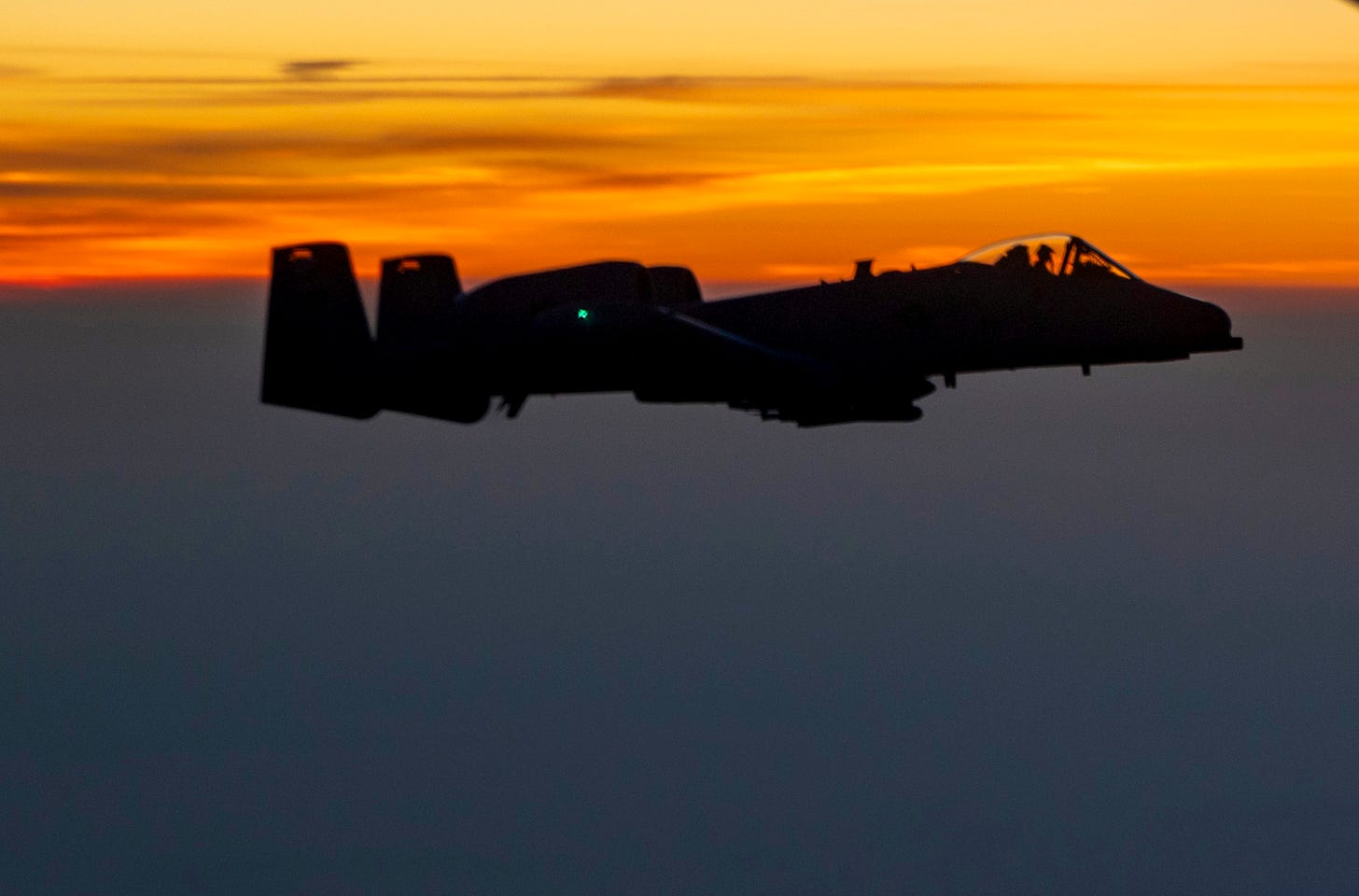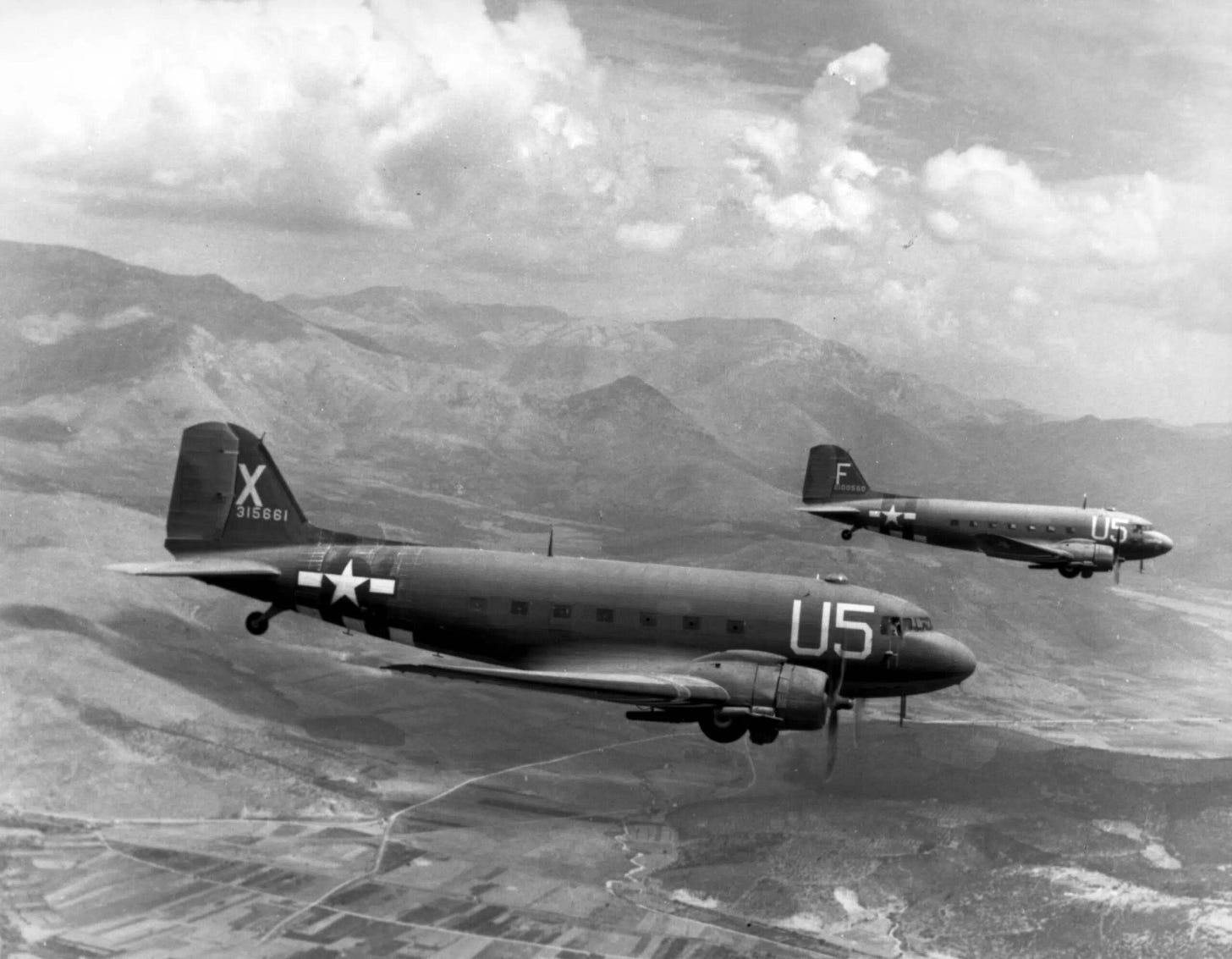Warthog Sunset: USAF Charts Final Flight Path for the A-10
Also: The final flight of the USAF’s last operational C-47 Skytrain marks the end of a legendary aircraft that served from World War II through Vietnam
“A warthog does not choose the battle; it simply faces whatever comes with grit and courage.”
Mission Briefing
The A-10 Warthog’s Long Goodbye: USAF Plans to Retire the Legendary Attack Aircraft by 2030
The Air Force’s long-anticipated farewell to the A-10 Thunderbolt II—affectionately known as the Warthog—is now official. At the Air and Space Forces Association's Warfare Symposium in Aurora, Colorado, Air Force Chief of Staff Gen. CQ Brown confirmed that the service plans to fully retire the A-10 fleet within the next five to six years.
The A-10 has long been a beloved and battle-tested symbol of American airpower. Designed during the Cold War with tank-busting in mind, it quickly earned legendary status for its unmatched ability to deliver close air support (CAS). With its titanium “bathtub” cockpit, straight wings, and iconic GAU-8/A Avenger 30mm cannon—a weapon that fires 3,900 rounds per minute—the A-10 was purpose-built for one job: destroy enemy armor and protect troops on the ground.
That mission earned the Warthog a fearsome reputation and fierce loyalty from the soldiers it defended. Whether flying over Iraq, Afghanistan, or Kosovo, the A-10’s presence overhead often meant the difference between life and death for ground forces pinned down in a firefight.
But now, the Air Force says the battlefield has changed—and the A-10 no longer fits the fight ahead.
“The A-10 is a great airplane… in an uncontested environment,” Gen. Brown explained. “The challenge is, we’re going to be in more contested environments in the future.” In other words, against a peer adversary like China, where modern air defense systems dominate, the A-10’s slow speed and low-altitude flight profile could make it vulnerable.
For years, the Air Force tried to begin retiring the aircraft, but was blocked by Congress—often at the urging of lawmakers and veterans who believed the A-10 still had a critical role to play. That standoff finally broke with the approval of the fiscal 2023 budget, which greenlit the retirement of the first 21 A-10s.
Those aircraft will come from the Indiana Air National Guard’s 122nd Fighter Wing at Fort Wayne, which will transition to flying F-16s. The drawdown reduces the overall A-10 fleet from 281 to 260 aircraft this year. From there, Gen. Brown expects continued retirements annually until the aircraft is fully out of service by 2030.
One of the key criticisms from Air Force leadership is that the A-10 is a “single-mission” platform. In an era where multi-role flexibility is prized, aircraft like the F-35 offer more value across the spectrum of air operations, from deep strike to electronic warfare to CAS.
Brown also acknowledged a shift in combatant command priorities, noting that commanders are not requesting the A-10 as much anymore. In the Middle East, the Warthog was a staple. But in the Pacific or against more sophisticated threats, its utility sharply declines.
Still, the retirement of the A-10 marks the end of an era. Since entering service in 1977, the Warthog has been a mainstay of American airpower. It survived multiple attempts to shelve it, proved its worth in every war since Desert Storm, and became a cult icon in military aviation.
Its retirement isn't just about retiring a plane—it’s about closing the book on a doctrine of air support that defined U.S. operations for over 40 years.
The Warthog may be flying off into the sunset, but its legacy—of toughness, survivability, and devotion to the troops on the ground—will endure long after the last GAU-8 burst echoes through the sky. BRRRRRRRRT!
This Week in Aviation History
30 June 1975 – Farewell to a Legend: The Last USAF C-47 Skytrain Retires
Its amazing to think that the C-47 Served with the USAF into the mid 1970s. These airplanes were (and are) so versatile that they are like the F-150s of the air transport world. They basically can do it all. On 30 June 1975, the United States Air Force officially retired its last operational Douglas C-47 Skytrain, tail number 43-49507, marking the end of over three decades of faithful service. With a remarkable 20,831 flight hours logged, this veteran aircraft was flown to its final resting place—the National Museum of the United States Air Force at Wright-Patterson AFB in Ohio—where it remains on display today.
Though designated a C-47D at retirement, the aircraft was originally built in Oklahoma City as a C-47B-15-DK. The “B” model featured more powerful Pratt & Whitney R-1830-90 Twin Wasp engines, equipped with two-speed superchargers for better high-altitude performance. These enhancements made the Skytrain a more versatile and capable workhorse in challenging operational theaters. Post-war, many of these superchargers were removed or disabled, leading to the “D” reclassification.
The C-47 Skytrain, known to British and Commonwealth forces as the Dakota, was a military adaptation of the iconic Douglas DC-3 commercial airliner. Introduced in 1941, the C-47 distinguished itself from its civilian cousin with the addition of a reinforced cargo floor, larger cargo door, glider-towing capacity, and an astrodome for celestial navigation. Rugged, reliable, and endlessly adaptable, the Skytrain could carry up to 9,485 pounds of cargo, 27 paratroopers, or 24 stretchers with two medical attendants.
With a cruising speed of 185 mph and a service ceiling of over 22,000 feet, the C-47 proved essential across multiple roles. It was 64 feet long with a 95-foot wingspan and powered by a pair of 14-cylinder radial engines producing up to 1,200 horsepower each at takeoff.
Few moments in military aviation history are as defining as D-Day, when an armada of C-47s spearheaded the airborne assault into Nazi-occupied France. Flying in tight “Vee of Vees” formations, more than 800 Skytrains dropped over 13,000 American paratroopers and nearly 8,000 British and Canadian troops behind enemy lines in the early hours of June 6, 1944.
But the Skytrain’s story didn’t end in Europe. During the Vietnam War, the airframe once again proved its adaptability when over 50 were converted into the AC-47 “Spooky” gunships. Armed with three side-firing miniguns capable of unleashing a storm of 12,000 rounds per minute, the AC-47 offered deadly and reliable close air support, becoming a legend in its own right.
From hauling supplies over the Himalayas during World War II to flying gunship missions in Southeast Asia, the Douglas C-47 Skytrain carried more than just cargo and troops—it carried the hopes, fears, and fates of a generation. And while its operational service may have ended in 1975, the Skytrain’s legacy remains very much alive.
In Case You Missed It
A deep dive into the B-36 Peacemaker, despite only serving for 10 years it made some amazing accomplishments:
Quick note about the above video, the National Museum of the US Air Force was kind enough to send me some photos that I used in the video, if you ever have the opportunity, give them a visit:
Photo Outlet
Every issue of Hangar Flying with Tog gets you a free image that I’ve taken at airshows:
Feel free to use these photos however you like, if you choose to tag me, I am @pilotphotog on all social platforms. Thanks!
Post Flight Debrief
Like what you’re reading? Stay in the loop by signing up below—it’s quick, easy, and always free.
This newsletter will always be free for everyone, but if you want to go further, support the mission, and unlock bonus content, consider becoming a paid subscriber.
Your support keeps this flight crew flying—and I couldn’t do it without you.
– Tog









The plane is an Grumman F8F Bearcat, successor to the Grumman F6F Wildcat.
Neat stuff on the 36. TY Sit 🇺🇸